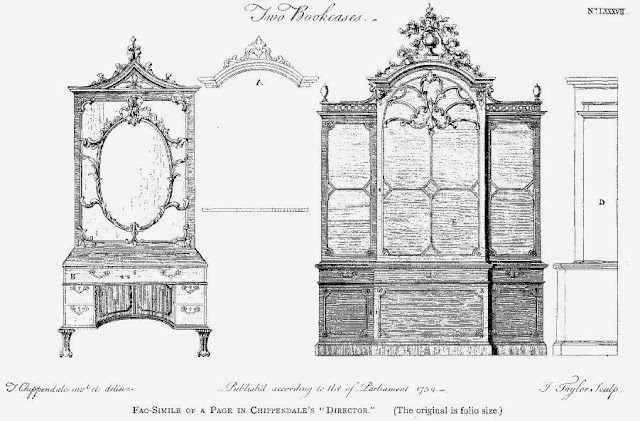What is Queen Anne, so I thought I'd spend a little time today telling you about Chippendale furniture.
In chronological order, Chippendale furniture came after Queen Anne, though there was significant overlap, with both styles being made in the same cabinetmaker shops at the same time, and often being combined in one piece of furniture, so that we would term a piece as Queen Anne or Chippendale based on which period's design elements are most predominantly expressed in said piece of furniture.
Thomas Chippendale (1718-1779), as you might guess from his name, was the father of the Chippendale furniture movement, and arguably had the greatest impact on furniture design of any one person in history. The Chippendale family of Yorkshire had a long lineage in the woodworking and cabinetmaking field. Thomas Chippendale may have started his education under the tutelage of his father, and later completed his apprenticeship with Richard Wood of York. By most accounts, Chippendale was a moderately skilled cabinetmaker, not at the top of his field, but generally well regarded. What he may have lacked in furniture finesse, he made up for with creativity. In 1754 Chippendale published The Gentleman and Cabinetmaker's Director. The publication was ground breaking, the first book of furniture designs ever to be published. Chippendale's immensely creative and whimsical designs incorporated elements of Rococo, Gothic, Chinoiserie, Queen Anne, Mannerist, and Jacobean. As you could imagine, the result was seriously decadent and detailed. Here are a few excerpts from the Director:
 |
| Chippendale Secretary Design source |
 |
| Chippendale Chinoiserie chairs source |
 |
| Chippendale bookcase designs source |
Now as with all design books, the forms pictured within were extreme in style and ornamentation. Cabinetmakers in England, Europe, and North America, who were heavily influenced by the publication, sampled from the Director based on personal preference, level of ability, and stylistic demands of their individual local market. In metropolitan areas like London, New York, and Philadelphia the very best cabinet makers integrated many of the fanciful and decadent elements of floral swags, embellishment, finials, shells, fans, and cartouches. The resulting furniture is remarkably ornate and striking, rendered with the finest materials, imported mahogany, locally sourced cherry and walnut, and bedecked with English brass hardware. In more conservative and rural regions, especially Puritanical New England, Chippendale furniture was more moderate, lacking the garish style of the original designs. The furniture made in these regions is none the less excellent in quality and craftsmanship- and being biased, I would argue that New England Chippendale is the most handsome.
I would be remiss in writing a Chippendale post without mentioning that most recognizable design device, the ball and claw foot. Thomas Chippendale drew inspiration heavily from the natural world, as was typical of all Rococo design of the mid 18th century. The ball and claw foot reached its highest level of perfection in the deft hands of New England's most skilled cabinetmakers, the Townsend family of Newport Rhode Island. The Townsends took the foot a step further by separating each talon from the ball it grasps, a style referred to as "open talon". The level of skill required to complete such a task is staggering. If you ever find an open talon ball and claw foot in the wild, I encourage you to take a good amount of time considering that piece of furniture as true Newport Chippendale furniture is some of the finest, rarest, and therefore most valuable on the antiques market.
Here's a wonderful example of a Chippendale highboy signed by John Townsend and dated 1756. Note the quality of construction, masterful carving of the feet, shell, and finials, and the soft patina. If you follow the link to Sotheby's, you'll see what a highboy of this quality is worth.
 |
| Here's an English 18th century Chippendale bookcase that bears a striking resemblance to Chippendale's original design - see images at top of post. source |
 |
| A beautiful Philadelphia Chest on Chest with ogee feet, scrolled pediment, and ornate floral cartouche. source |
 |
| A wonderful Chippendale lowboy, Philadelphia, with ball and claw feet, carved knees, ornate shaped apron, and carved center drawer. source
In the American Colonies, Chippendale furniture was it it's height from 1760-1800, with each region interpreting the style with delightful individuality that allows the antiques collector to narrow down region of origin with accuracy. By 1790 the opulence of the mid 18th century was becoming passé. Influenced by the American and French revolutions, art, design, culture as whole began the inevitable shift towards simplicity that always follows times of great extravagance. In America, this new trend was called the Federal Period, which we'll cover in another post.
Chippendale form did not disappear from the cabinet maker's vocabulary, however. Forms first introduced in the Director were referenced frequently, reinterpreted in Federal, Classical, and Victorian styles as tastes changed. Chippendale furniture once again shot to the forefront in the early 20th century with the Colonial Revival- with pieces being mass produced in near identical replicas of the original 18th century forms, though lacking the quality that only handmade furniture has. Here's a nice example of a Lane cedar chest in the form of a Philadelphia Chippendale Lowboy- note the similarity to the 18th century piece above.
|




This is just the kind of post I love! Great history here, and I love the Chippendale style. Thanks so much for sharing this at the We Call It Olde Link-Up. -Dawn @ We Call It Junkin.com
ReplyDelete